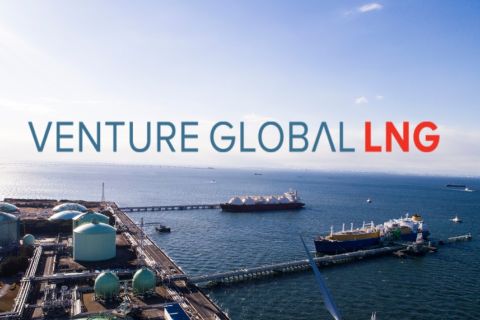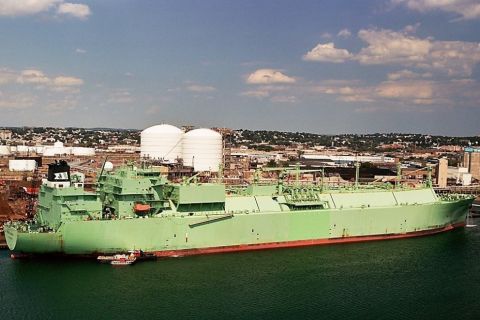
Max Deffenbaugh, principal scientist at Aramco, speaking during the Driving Value Through Innovation session at OTC. (Source: OTC)
Leviathan operators such as Aramco are among companies that pace the oil and gas industry through massive projects and innovations in technology.
“Our technologies, once they’re developed and they reach an appropriate level of development for a field test, they also oversee the scale up and ultimate licensing of the technology to a commercialization partner,” Max Deffenbaugh, principal scientist for Aramco, said during the 2024 Offshore Technology Conference in Houston. “This system has served us very well in terms of allowing us to respond quickly to new opportunities and to change directions when necessary to take advantage of opportunities.”
Deffenbaugh emphasized the importance of capitalizing on emerging trends and breakthroughs to focus on technologies that address industry needs and offer significant value propositions.
“We might call these disruptive technologies; ones that are not just replacing an old instrument but are going to change your business model, change how you do a certain function within your organization,” he said. “Those kinds of technologies can also be very difficult to implement from an outside partner into an oil company.”
Communicating with stakeholders involved in old processes helps ensure new business processes address all concerns and needs, he said.
Central to Aramco’s innovation strategy is its emphasis on collaboration. By engaging with external partners and fostering collaborative innovation, Aramco’s development and deployment of technology is easier without the “barriers and proprietary information that can’t be shared between companies,” Deffenbaugh said.
Aramco is also develop in-house “disruptive technologies.”
“The internal development path is a road less traveled by most oil companies today, but we think it’s an important capability in our development portfolio,” Deffenbaugh said.
One such technology Aramco developed internally is drilling fluid analysis tool Mudfork.
Mudfork’s sensor utilizes a tuning fork design to measure the density and viscosity of drilling fluids. By analyzing the resonance frequency and damping of the tuning fork’s prongs, Mudfork provides real-time data on fluid properties, enabling more informed decision-making during drilling operations.
The tool’s versatility led to the adaptation of similar sensors for applications such as hydraulic fracturing fluid analysis and polymer EOR fluid characterization, highlighting its broad utility across various oilfield operations.
Aramco also developed the Sensor Ball, a device designed to collect downhole data without the need for wireline equipment.
“You put it through the tree of your well, opening the valves one at a time… it falls to a program depth and then magnetically releases a small dissolvable weight. Once it releases the weight, it’s now neutrally buoyant and it floats back up to the surface,” he said.
At the end of a shift, a field technician can return that day and open the valves one at a time to bring the Sensor Ball up to the top of the tree and then pick it out from the cap of the well, download the data into a cell phone or tablet computer and email it to an expert at Aramco’s headquarters in Dhahran “to get an immediate interpretation of what’s going on in the well,” he said.
By deploying the untethered Sensor Ball into the wellbore, field engineers can access real-time data on well conditions, significantly lowering costs to get downhole data and making it much easier to access downhole data, said Deffenbaugh.
A propeller-driven downhole robot designed to float in wellbore fluids, Aramco’s KASHF, is also used for wellbore navigation and data acquisition. Unlike traditional tractor-based tools, the buoyancy-driven propulsion system reduces energy consumption and enables precise movements and extended mission durations. Coupled with its onboard sensors, KASHF is able to navigate complex well architectures and unlock new wellbore insights.
Bringing two approaches together
To get the best results, Aramco has learned to combine its in-house technology development approach with its commitment to fostering a culture of openness.
Aramco’s Downhole Robotics Challenge is a program created by Aramco in which participants propose development ideas for their downhole robots.
For tech like KASHF, Aramco’s collaborative approach ensures that it continues to evolve and adapt to meet the evolving needs of the industry.
“By engaging with the external community of innovative people, we may be able to bring in some ideas for new things to put on KASHF that would create new measurement capabilities for it, and that we can help with overcoming that barrier to innovation by allowing the access to the downhole testing in the real wells so that people can show the value of their products.”
And in an effort to commercialize the Mudfork technology, Aramco has initiated an internal funding program aimed at scaling up production and facilitating field deployment. Recognizing the significant cost implications associated with mass production and widespread deployment, Aramco is actively engaging with partners to support manufacturing and pilot studies.
But collaboration is not without its difficulties.
The commercialization of Sensor Ball and KASHF presents unique challenges due to differing interests between Aramco and potential commercialization partners.
“Sensor Ball and KASHF are a little trickier because what Aramco wants is a massive savings and how much it costs to get downhole data. And if you partner with a company who's interested in continuing to get a lot of money for logging, well then it can be difficult to find an alignment of interest.”
By working through challenges to deliver value-driven solutions and embrace collaborative innovation, Aramco remains at the forefront of industry transformation to drive sustainable growth and progress.
Recommended Reading
Aethon to Acquire Tellurian Haynesville Shale Assets for $260MM
2024-05-29 - Aethon Energy is acquiring Tellurian Inc.'s Haynesville Shale assets in a $260 million deal, allowing Aethon to continue growing as the basin's top private producer and for financially struggling Tellurian to prioritize its flagship Driftwood LNG project.
Aramco to Source Shale Feed-gas from NextDecade’s RGLNG Train 4
2024-06-13 - Aramco looks to offtake LNG from NextDecade Corp.’s Rio Grande LNG Train 4 in Brownville, Texas. A move that will source feed-gas from the Permian and Eagle Ford.
FERC Approves Venture Global’s Calcasieu Pass 2 LNG Project
2024-06-27 - Venture Global’s Calcasieu Pass 2 was delayed due to changes at the overall site and within U.S. environmental law. The project remains subject to the LNG export pause initiated by the Biden administration.
Glenfarne Seeks Five More Years to Build Texas LNG Export Plant
2024-05-29 - Glenfarne said in its FERC filing that the project was delayed due to "extenuating circumstances outside of Texas LNG's control."
Constellation Energy’s Boston LNG Import Terminal Remains Open
2024-06-24 - FERC warned last year that plans to shut Constellation’s Everett LNG terminal could threaten the Northeastern power grid.





